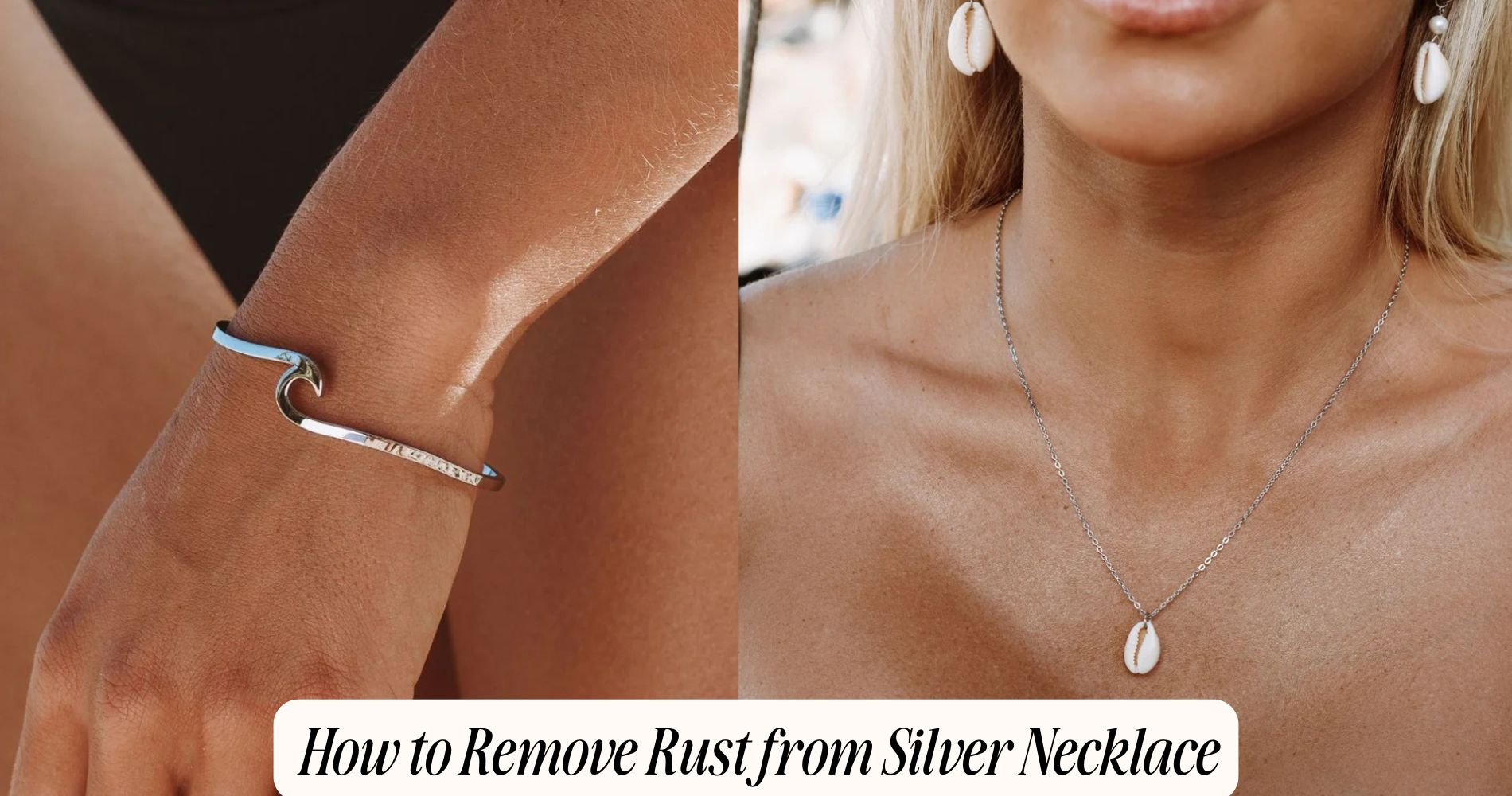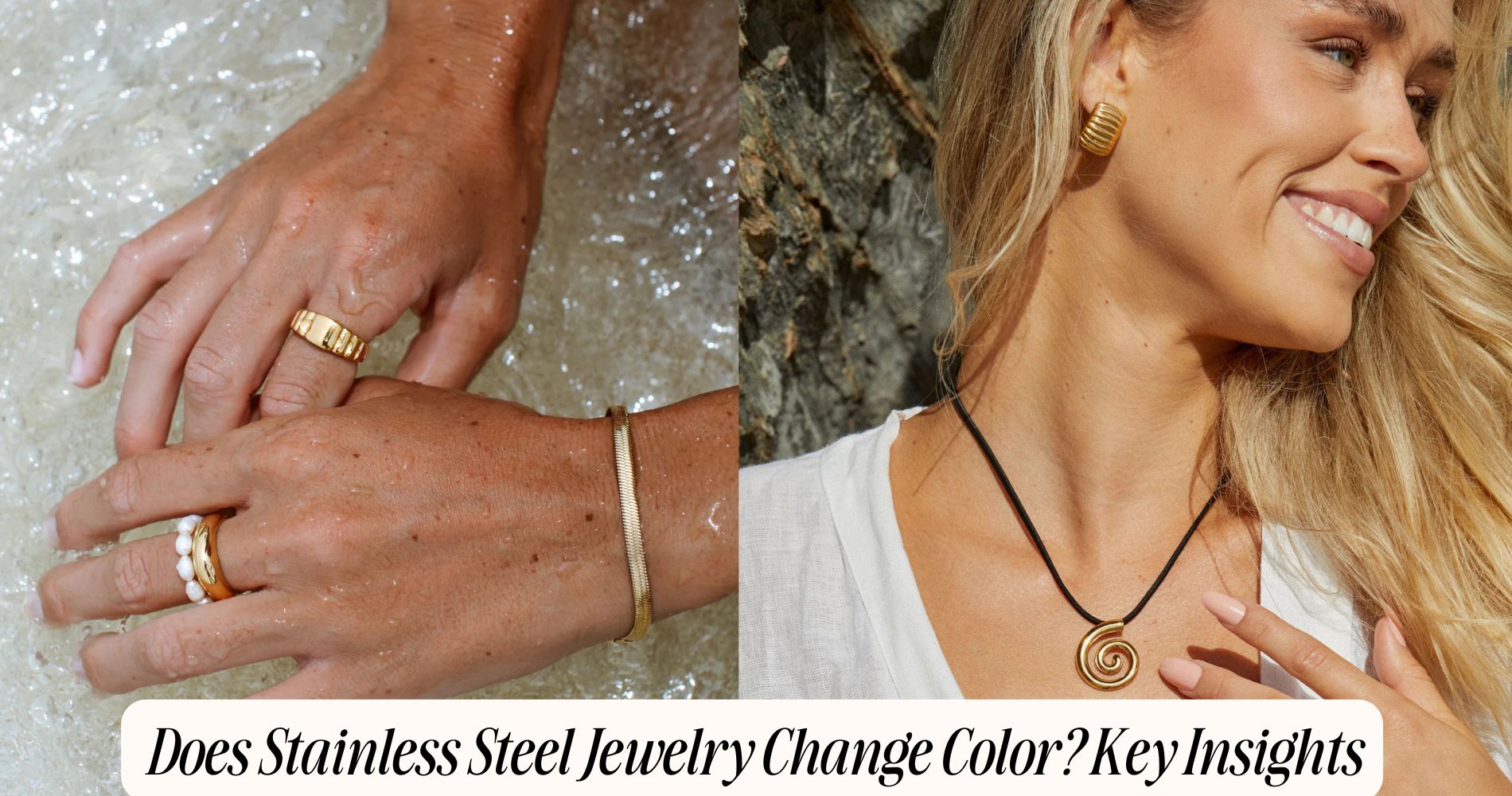
How to Remove Rust From Silver Necklace
How to Remove Rust from Silver Necklace. If you're wondering how to remove rust from a silver necklace, the process is simpler than you might think. Start by making a baking soda paste using three parts baking soda and one part water. Gently apply the paste with a soft cloth, scrubbing in circular motions to remove rust or tarnish. For tougher spots, soak the necklace in white vinegar for 15 minutes, then rinse thoroughly. Use a soft-bristle toothbrush to clean intricate designs, ensuring all residue is removed. Always dry your necklace immediately to avoid moisture issues. Regular cleaning and proper storage in a dry, airtight container will help prevent rust and keep your silver necklace looking stunning. Explore our Silver Waterproof Jewelry Collection for durable and stylish pieces that resist tarnish and rust.
Understanding Rust on Silver
When you think of rust, you might picture it on iron or steel, but silver can also suffer from tarnishing, which some may mistakenly refer to as rust. This tarnishing is primarily due to silver oxidation, a chemical reaction that occurs when silver interacts with sulfur compounds in the air or on your skin. The result is a dark, dull layer that detracts from the metal's natural shine.
Understanding rust formation on silver is essential for proper care. Unlike iron, which rusts through the formation of iron oxide, silver undergoes oxidation to create silver sulfide. This process can occur more rapidly in humid environments or when the silver comes into contact with certain chemicals, such as those found in lotions or perfumes.
While tarnishing doesn't compromise the structural integrity of the silver, it can be unsightly and unwanted. Regular maintenance and proper storage can help minimize tarnishing and keep your silver jewelry looking its best.
Knowing how oxidation affects your silver will empower you to take proactive steps in its care, ensuring your necklace remains a beautiful accessory for years to come.
Essential Tools and Materials
To effectively remove tarnish from your silver necklace, gathering the right tools and materials is essential. Start by collecting basic cleaning supplies, such as a soft cloth, a toothbrush with soft bristles, and a bowl for mixing solutions. These items will help prevent scratching your necklace while ensuring thorough cleaning.
Next, you'll need rust removers specifically designed for silver. Look for products that are non-abrasive and safe for use on delicate jewelry. Common options include baking soda mixed with water to form a paste or commercial silver cleaners that effectively eliminate rust without damaging the metal.
Additionally, having a pair of gloves on hand is a good idea to protect your skin from chemicals in rust removers. If you prefer natural methods, white vinegar and lemon juice can also be effective rust removers.
Lastly, a microfiber cloth is invaluable for polishing the necklace after cleaning, restoring its shine and luster. By assembling these essential tools and materials, you'll set yourself up for success in the cleaning process, ensuring your silver necklace looks as good as new.
Simple Cleaning Methods
Once you've gathered your tools and materials, you can start with some simple yet effective cleaning methods to tackle rust on your silver necklace.
One popular homemade remedy is using a mixture of baking soda and water. Create a paste by combining three parts baking soda with one part water. Apply this paste to the rusted areas using a soft cloth or sponge, gently rubbing in circular motions. Rinse thoroughly with lukewarm water and pat dry with a soft cloth.
Another effective method involves using white vinegar. Soak your necklace in a bowl of white vinegar for about 15 minutes. After soaking, take a soft-bristle toothbrush to gently scrub away any remaining rust. Rinse the necklace and dry it immediately.
For polishing, consider using a silver polishing cloth specifically designed for jewelry. These cloths can remove tarnish and enhance the shine of your silver without scratching it. Simply rub the cloth on the necklace in a back-and-forth motion.
Advanced Rust Removal Techniques
When simple cleaning methods fall short, you might consider advanced techniques like electrolytic rust removal or specialized chemical rust removers.
These methods can effectively target and eliminate rust without damaging your silver necklace.
Electrolytic Rust Removal
Electrolytic rust removal offers an efficient, scientifically grounded method to restore your silver necklace to its original brilliance. This electrolytic method utilizes an electric current to reverse the oxidation process that causes rust.
To begin, you'll need a container, a power supply, and a sacrificial anode, often made of stainless steel or another metal.
First, fill the container with a solution of water and baking soda. This acts as an electrolyte, enhancing conductivity. Next, submerge your silver necklace along with the sacrificial anode, ensuring they're not touching.
Connect the positive lead of your power supply to the sacrificial anode and the negative lead to your necklace. When you power up the system, the current passes through the solution, causing rust to transfer from your necklace to the anode.
Monitor the process closely; this method typically takes a few hours. Afterward, remove your necklace, rinse it thoroughly, and dry it completely.
You'll find that the rust removal has left your jewelry looking rejuvenated. This precise technique not only effectively eliminates rust but also preserves the integrity of your silver.
Chemical Rust Removers
After exploring electrolytic rust removal, you might consider chemical rust removers as another effective option for restoring your silver necklace. These products contain specific compounds designed to initiate chemical reactions that break down rust efficiently.
When selecting a chemical rust remover, look for formulations that include rust inhibitors to prevent future corrosion.
Begin by ensuring your necklace is clean and dry. Apply the chemical rust remover according to the manufacturer's instructions, typically using a soft cloth or brush. The active ingredients will react with the rust, loosening its grip on the silver.
Allow the solution to sit for the recommended time, usually a few minutes, to let the chemical reactions work effectively.
After the designated time, gently scrub the affected areas to remove the rust. Rinse your necklace thoroughly with water to eliminate any residue from the remover, as lingering chemicals can cause further damage.
Finally, dry the necklace completely to prevent any moisture-related issues.
Using chemical rust removers can be a powerful method, but always prioritize safety by wearing gloves and working in a well-ventilated area. Following these steps will help you successfully restore your silver necklace while preventing future rust formation.
Preventing Future Rust Issues
To keep your silver necklace rust-free, focus on proper storage and a regular cleaning routine.
Store your necklace in a dry, airtight container to minimize exposure to moisture and air.
Additionally, establish a habit of cleaning your necklace every few weeks to prevent tarnish buildup and maintain its shine.
Proper Storage Techniques
Proper storage is vital for preventing rust issues on your silver necklace. To keep your jewelry in pristine condition, start by making sure it's stored in a dry environment. High humidity can accelerate rust formation, so controlling humidity is essential. Ideally, aim for a relative humidity level below 50%.
Use a soft, anti-tarnish pouch specifically designed for silver. These pouches often contain materials that absorb moisture and prevent tarnishing. If you don't have one, a clean, dry cloth can also work, just make sure it's free from any rough textures that might scratch your necklace.
Avoid storing your silver jewelry in areas like bathrooms or near windows where moisture can build up. Instead, opt for a cool, dark drawer or a jewelry box with desiccant packets to absorb any excess moisture.
Additionally, keep your silver necklace separate from other jewelry pieces to prevent scratches and tangling. Using a dedicated compartment or a soft-lined tray can help maintain its luster.
Regular Cleaning Routine
Incorporating a regular cleaning routine is essential for maintaining the shine and integrity of your silver necklace. Ideally, you should clean your necklace every few weeks, depending on how often you wear it. If you wear it daily, consider increasing your cleaning frequency to once a week to prevent rust and tarnish buildup.
Start by using a soft, lint-free cloth to gently wipe down your necklace after each wear. This simple maintenance tip helps remove oils and moisture, which can contribute to rust.
For a deeper clean, mix a few drops of mild dish soap with warm water and soak your necklace for a few minutes. Then, use a soft brush to gently scrub any intricate designs, ensuring you reach all surfaces.
After rinsing with clean water, dry your necklace thoroughly with a soft cloth to prevent any water spots.
Additionally, consider using a protective polish specifically designed for silver to create a barrier against tarnish. By following these maintenance tips and establishing a consistent cleaning frequency, you'll protect your silver necklace from rust and keep it looking beautiful for years to come.
Caring for Silver Jewelry
Caring for silver jewelry requires attention to detail and a proactive approach to maintenance. To guarantee your pieces remain stunning and free from tarnish, establish a consistent silver maintenance routine.
Start by cleaning your jewelry regularly with a soft, lint-free cloth to remove dirt and oils that can cause tarnishing.
When storing your silver pieces, choose a cool, dry place away from direct sunlight. Use anti-tarnish pouches or cloths to help minimize exposure to moisture and air, which are major contributors to tarnish.
Avoid storing silver jewelry in humid environments, like bathrooms, as this can accelerate oxidation.
Additionally, be mindful of when you wear your silver jewelry. Remove it before engaging in activities that involve exposure to harsh chemicals or sweat, such as swimming or exercising. This simple precaution is essential for effective jewelry care.
If your silver jewelry does become tarnished, address it promptly using a specialized silver cleaner or a mild soapy solution.
Frequently Asked Questions
Can I Use Vinegar to Remove Rust From Silver?
Yes, you can use vinegar to remove rust. Its acidity helps break down rust, offering vinegar benefits. To prevent future rust, guarantee you dry your items and store them in a moisture-free environment.
Is Rust on Silver Jewelry Harmful to Skin?
Rust on silver jewelry can cause skin irritation, particularly for sensitive individuals. While it's not typically harmful, rust effects may lead to discomfort or allergic reactions. It's best to clean your jewelry regularly to prevent these issues.
How Often Should I Clean My Silver Necklace?
You should clean your silver necklace every few weeks for ideal silver care. Regular cleaning frequency prevents tarnishing, keeping your jewelry looking its best. Don't forget to store it properly to maintain its shine between cleanings.
Will Rust Removal Damage the Silver Finish?
Rust removal can damage the silver finish if not done carefully. To maintain silver durability and guarantee rust prevention, use gentle methods and appropriate products designed for silver, avoiding harsh chemicals that could harm the surface.
Can I Use Baking Soda for Rust Removal?
Yes, baking soda's effectiveness lies in its mild abrasiveness. Combine it with water to form a paste. For rust prevention tips, store your items in a dry place and consider regular cleaning to minimize rust formation.
Conclusion
In summary, removing rust from your silver necklace doesn't have to be intimidating. By understanding the nature of rust, utilizing the right tools, and employing effective cleaning techniques, you can restore your jewelry's shine. Remember to take preventive measures to avoid future rust issues, and prioritize proper care for your silver pieces. With these tips, you'll keep your necklace looking beautiful and rust-free for years to come, ensuring it remains a cherished accessory.
























Leave a comment
This site is protected by hCaptcha and the hCaptcha Privacy Policy and Terms of Service apply.